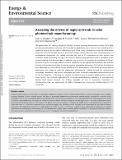| dc.contributor.author | Goodrich, Alan C. | |
| dc.contributor.author | James, Ted L. | |
| dc.contributor.author | Woodhouse, Michael | |
| dc.contributor.author | Buonassisi, Tonio | |
| dc.contributor.author | Powell, Douglas Michael | |
| dc.date.accessioned | 2013-11-15T16:03:00Z | |
| dc.date.available | 2013-11-15T16:03:00Z | |
| dc.date.issued | 2013-09 | |
| dc.date.submitted | 2013-03 | |
| dc.identifier.issn | 1754-5692 | |
| dc.identifier.issn | 1754-5706 | |
| dc.identifier.uri | http://hdl.handle.net/1721.1/82122 | |
| dc.description.abstract | The photovoltaic (PV) industry has grown rapidly as a source of energy and economic activity. Since 2008, the average manufacturer-sale price of PV modules has declined by over a factor of two, coinciding with a significant increase in the scale of manufacturing in China. Using a bottom-up model for wafer-based silicon PV, we examine both historical and future factory-location decisions from the perspective of a multinational corporation. Our model calculates the cost of PV manufacturing with process step resolution, while considering the impact of corporate financing and operations with a calculation of the minimum selling price that provides an adequate rate of return. We quantify the conditions of China's historical PV price advantage, examine if these conditions can be reproduced elsewhere, and evaluate the role of innovative technology in altering regional competitive advantage. We find that the historical price advantage of a China-based factory relative to a U.S.-based factory is not driven by country-specific advantages, but instead by scale and supply-chain development. Looking forward, we calculate that technology innovations may result in effectively equivalent minimum sustainable manufacturing prices for the two locations. In this long-run scenario, the relative share of module shipping costs, as well as other factors, may promote regionalization of module-manufacturing operations to cost-effectively address local market demand. Our findings highlight the role of innovation, importance of manufacturing scale, and opportunity for global collaboration to increase the installed capacity of PV worldwide. | en_US |
| dc.description.sponsorship | United States. Department of Energy. Office of Energy Efficiency and Renewable Energy (Contract DE-EE0005314) | en_US |
| dc.description.sponsorship | United States. Department of Energy. Office of Energy Efficiency and Renewable Energy (Contract DE-AC36-08GO28308) | en_US |
| dc.description.sponsorship | United States. Dept. of Defense (National Defense Science and Engineering Graduate Fellowship Program) | en_US |
| dc.description.sponsorship | National Science Foundation (U.S.) (CAREER Award ECCS-1150878) | en_US |
| dc.language.iso | en_US | |
| dc.publisher | Royal Society of Chemistry | en_US |
| dc.relation.isversionof | http://dx.doi.org/10.1039/c3ee40701b | en_US |
| dc.rights | Article is available under a Creative Commons license | en_US |
| dc.rights.uri | http://creativecommons.org/ | en_US |
| dc.source | RSC | en_US |
| dc.title | Assessing the drivers of regional trends in solar photovoltaic manufacturing | en_US |
| dc.type | Article | en_US |
| dc.identifier.citation | Goodrich, Alan C., Douglas M. Powell, Ted L. James, Michael Woodhouse, and Tonio Buonassisi. “Assessing the drivers of regional trends in solar photovoltaic manufacturing.” Energy & Environmental Science 6, no. 10 (2013): 2811. © Royal Society of Chemistry | en_US |
| dc.contributor.department | Massachusetts Institute of Technology. Department of Mechanical Engineering | en_US |
| dc.contributor.mitauthor | Powell, Douglas Michael | en_US |
| dc.contributor.mitauthor | Buonassisi, Tonio | en_US |
| dc.relation.journal | Energy & Environmental Science | en_US |
| dc.eprint.version | Final published version | en_US |
| dc.type.uri | http://purl.org/eprint/type/JournalArticle | en_US |
| eprint.status | http://purl.org/eprint/status/PeerReviewed | en_US |
| dspace.orderedauthors | Goodrich, Alan C.; Powell, Douglas M.; James, Ted L.; Woodhouse, Michael; Buonassisi, Tonio | en_US |
| dc.identifier.orcid | https://orcid.org/0000-0001-8345-4937 | |
| mit.license | PUBLISHER_CC | en_US |
| mit.metadata.status | Complete | |
